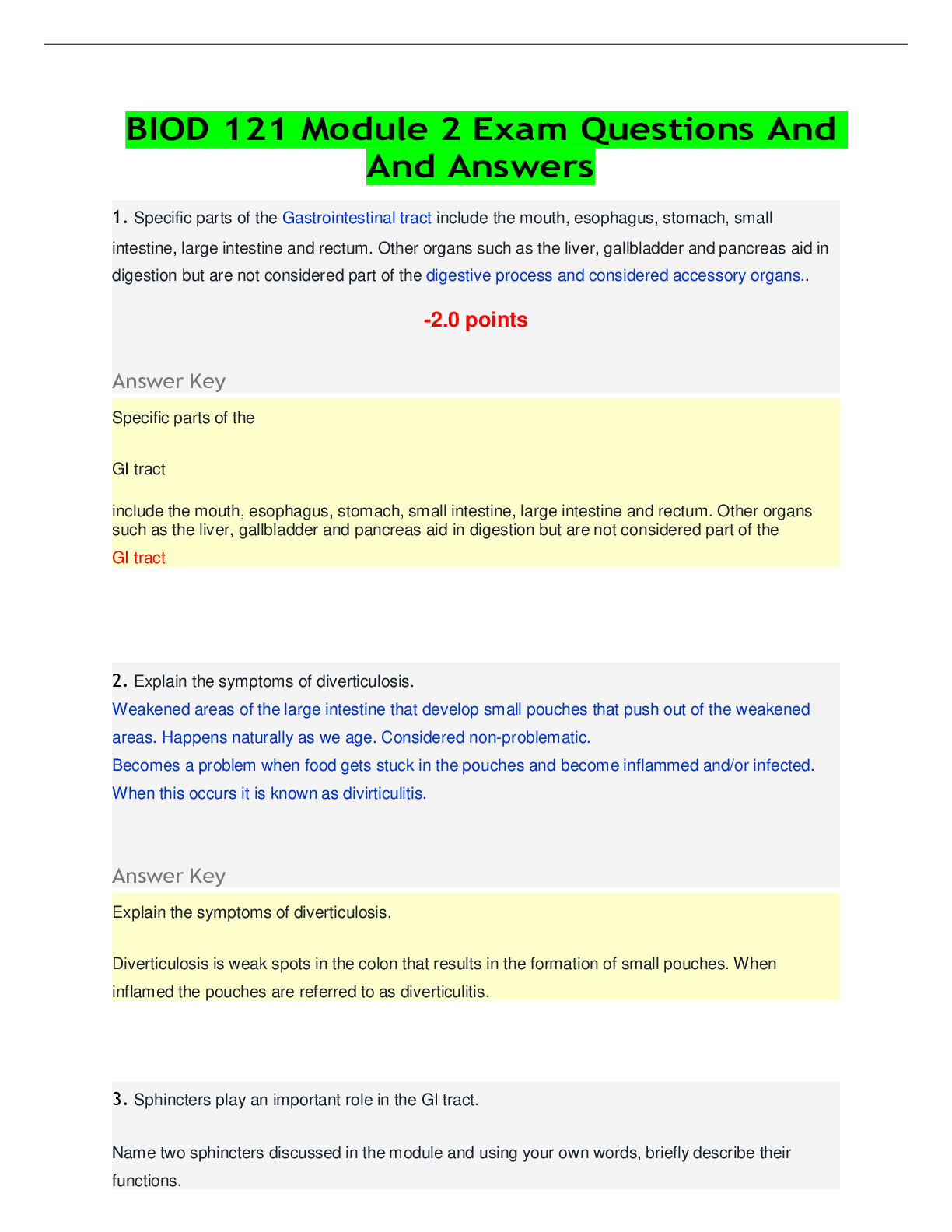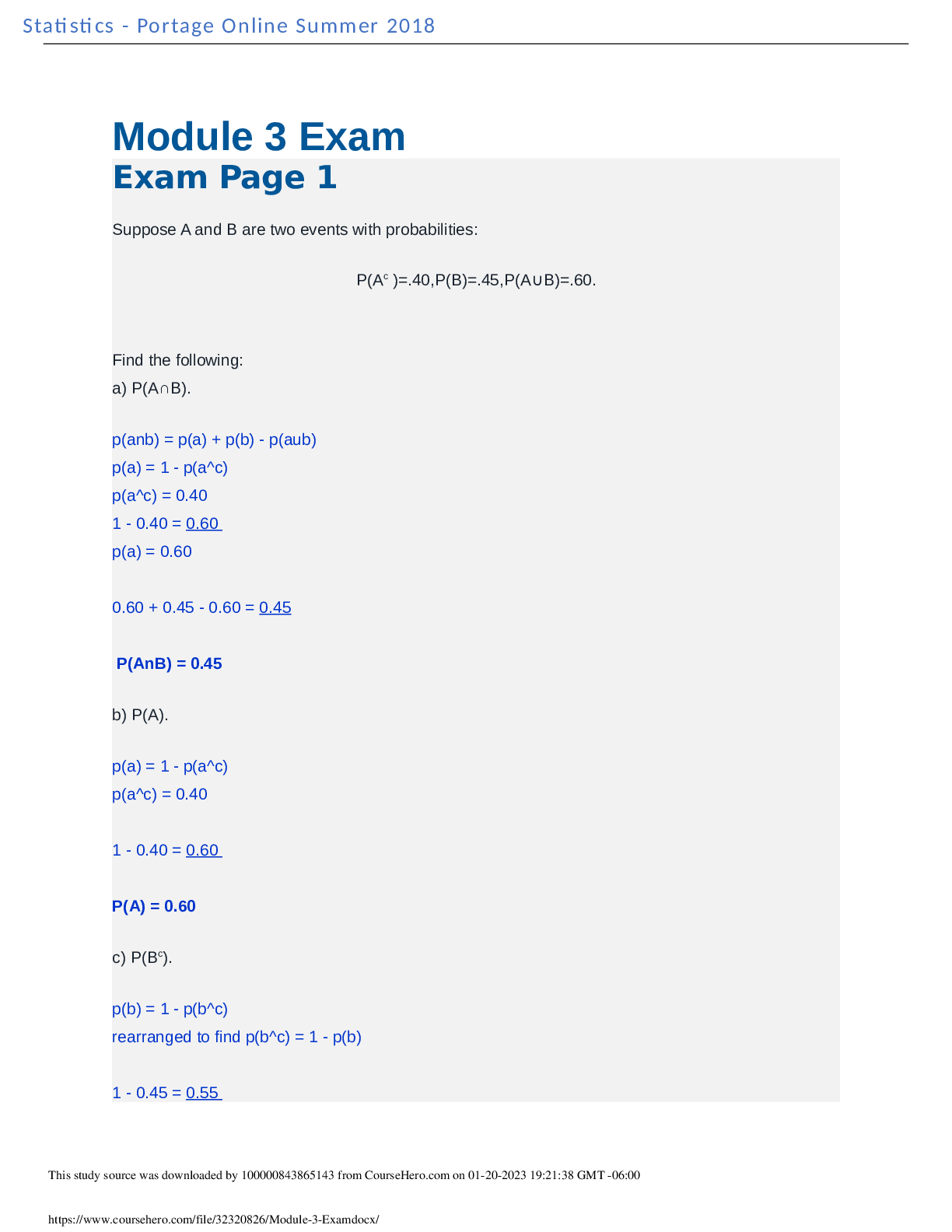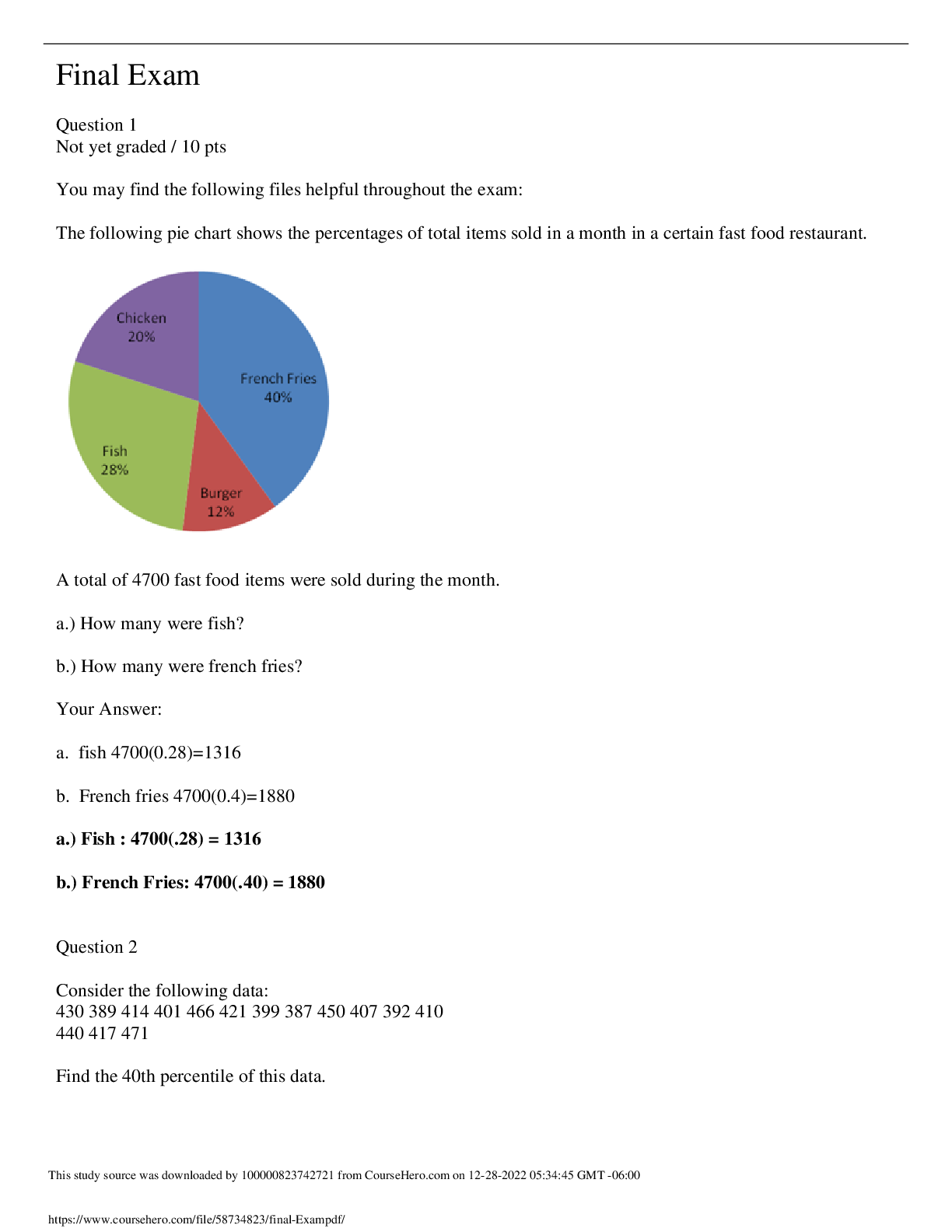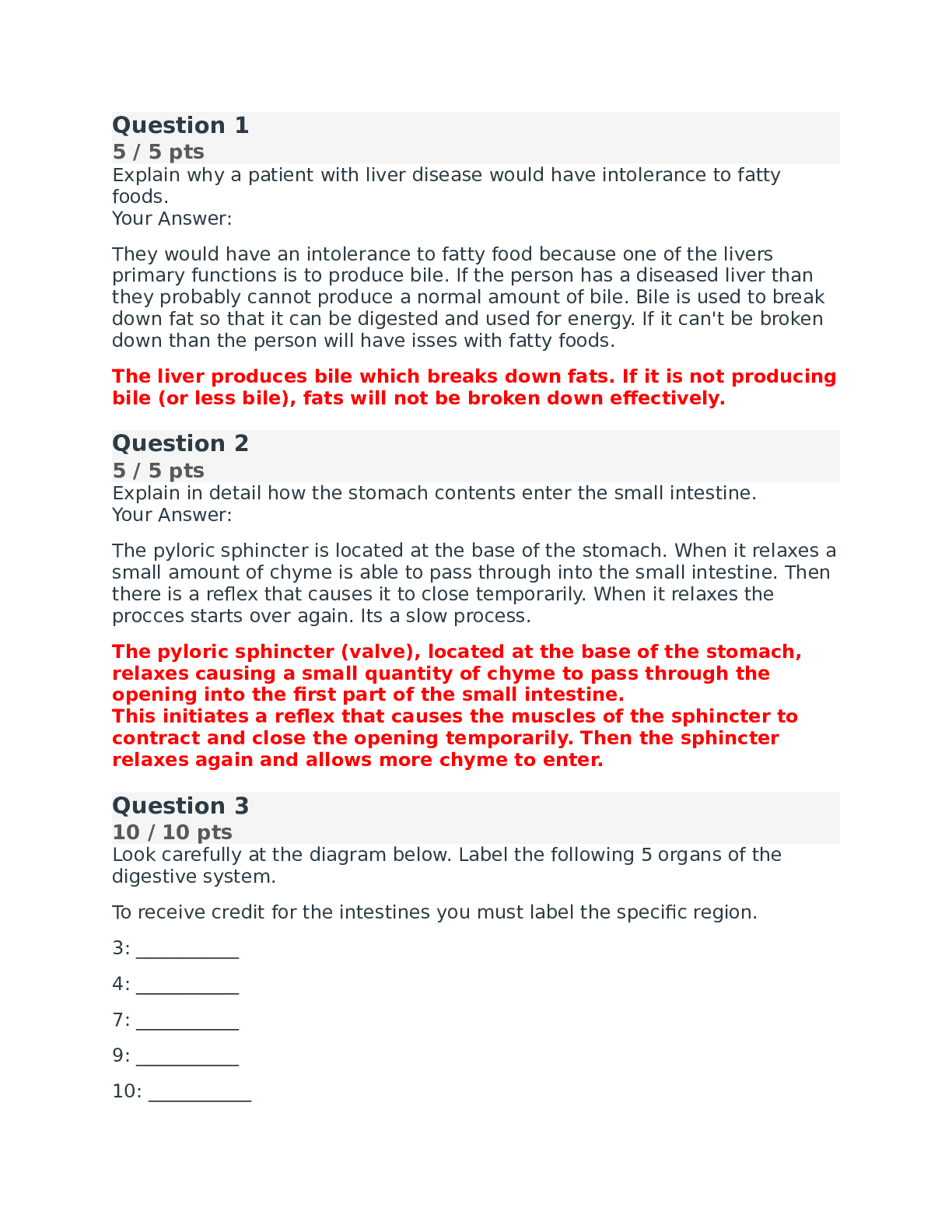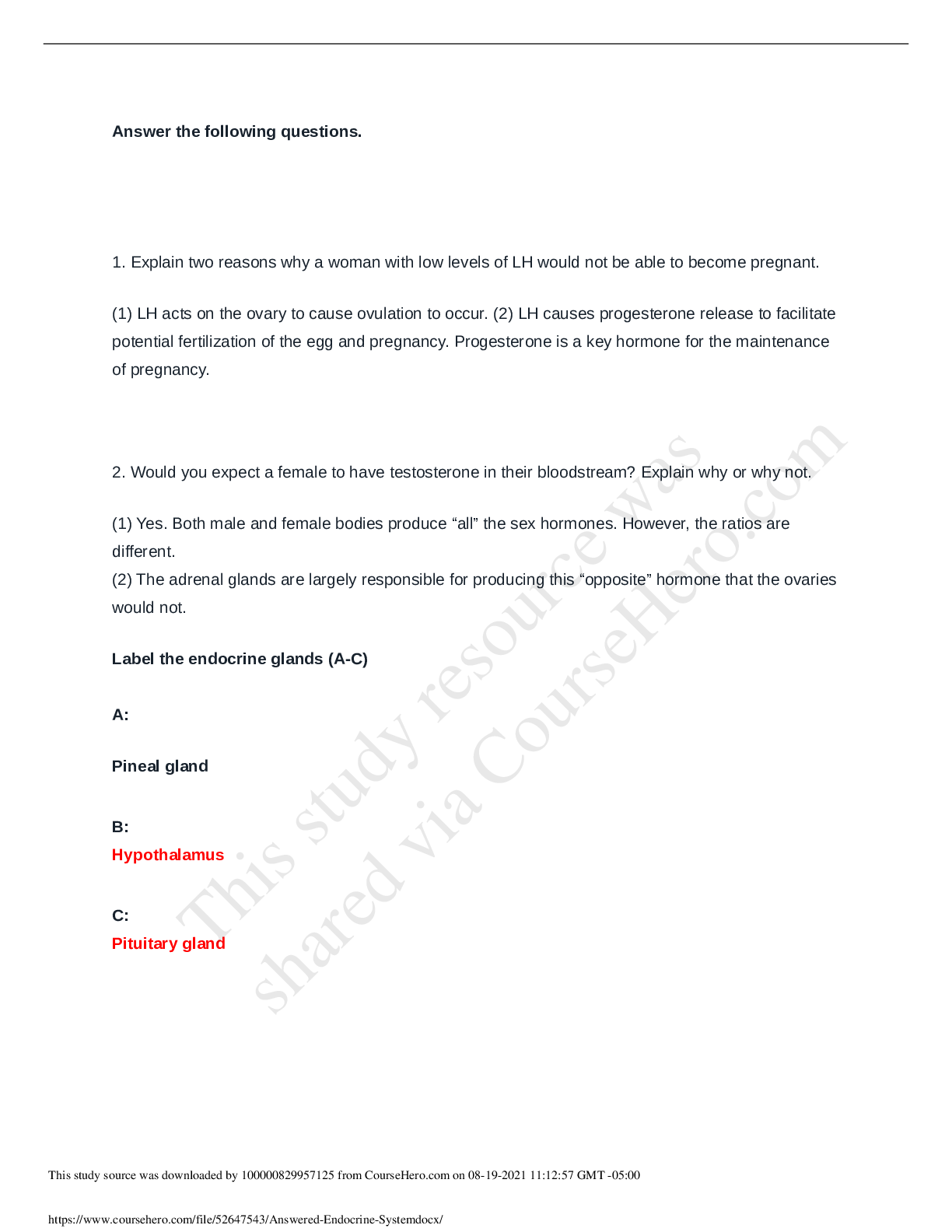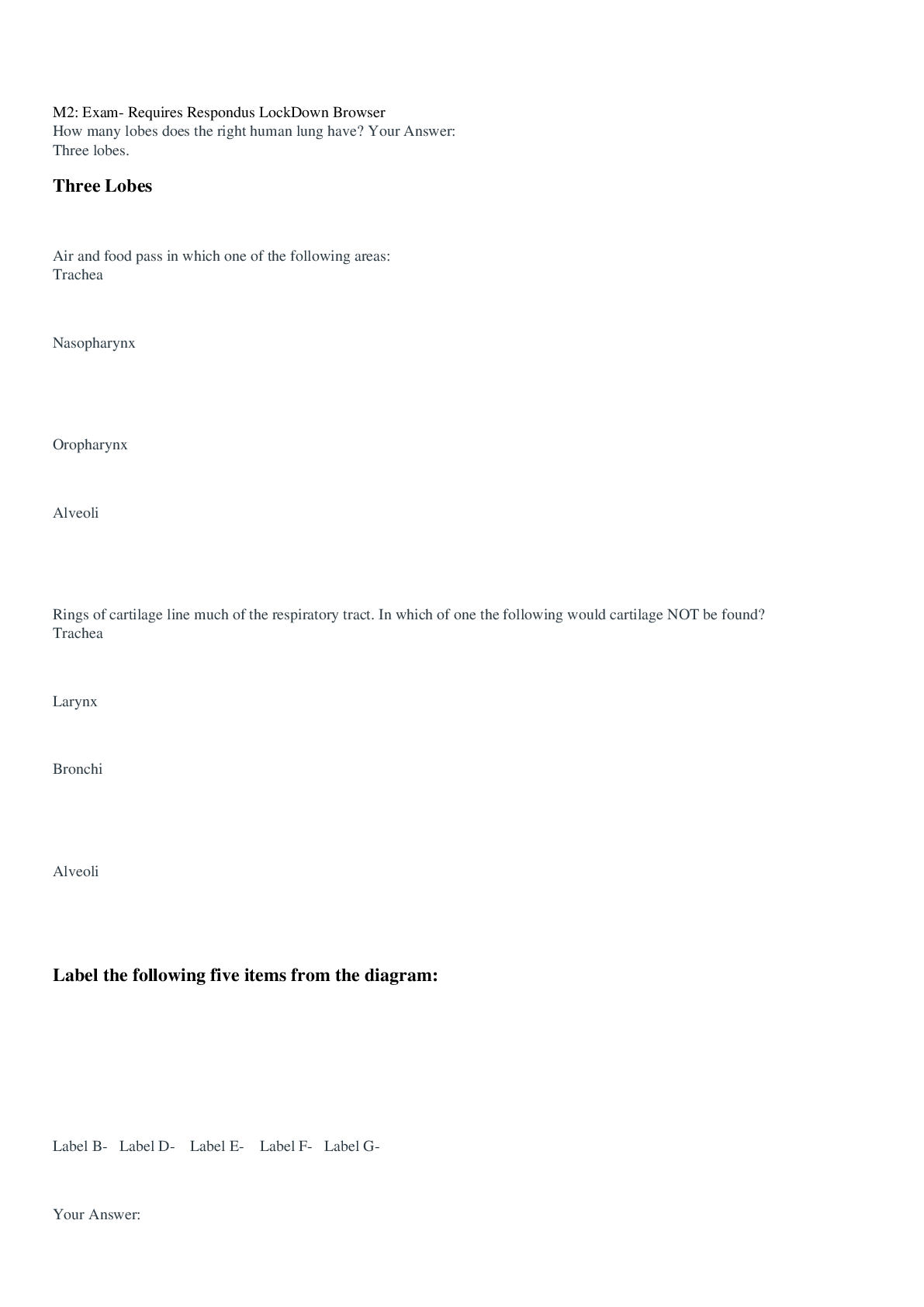A&P 1 101 Module 7 Exam (GRADED A+) Integumentary System- Portage Learning
Document Content and Description Below
A&P 1 101 Module 7 Exam (GRADED A+) Integumentary System Question 1 0 / 5 pts Identify the region and the layer of skin that is highlighted in blue. (Also indicated by the arrow, below) *NOTE: ... To receive full credit you must label two regions. Your Answer: papilary region of the dermis Stratum spinosum; Epidermis (Must have both for full credit) Question 2 5 / 5 pts A- Identify the sensory cell receptor highlighted in blue, below, also indicated by the arrow. B- What sensory information is detected by this type of receptor? Your Answer: A - Pacinian Corpuscles is amechanoreceptor that detects pressuer applied to the skin.Pacinian Corpuscles detects vibration. A) Pacinian corpuscle B) Detects pressure (mechanoreceptor) Question 3 3 / 3 pts The layers of the epidermis, from superficial to deep are: Correct! Stratum corneum, stratum granulosum, stratum spinosum, stratum basale. Stratum basale, stratum spinosum, stratum granulosum, stratum corneum Stratum spinosum, stratum granulosum, stratum corneum, Stratum basale Stratum corneum, stratum spinosum, stratum granulosum, stratum basale. Question 4 4 / 4 pts Endocrine glands secrete ; Exocrine glands secrete . A. for body-wide distribution, into an epithelial lining B. into an epithelial lining, for body-wide distribution C. through a duct, into the bloodstream D. into the bloodstream, through a duct Correct! E. A&D F. B&C Question 5 3 / 3 pts Which of the following is true regarding the epidermis: It is highly vascular. It is comprised of five distinct layers. Correct! The basement membrane contains its blood supply. Epidermal ridges change throughout a person’s lifetime. Question 6 7.5 / 10 pts Match the cell with its single best description, using each description only once. Correct! Keratinocytes You Answered Fibroblasts Correct Answer Produces collagen Correct! Melanocytes Correct! Langerhans cells Other Incorrect Match Options: • Detects light touch • Detects pain Question 7 3 / 3 pts A person touches a hot cup of coffee. What type of sensory organ detects this information? Your Answer: Thermoreceptors Thermoreceptor Question 8 3 / 3 pts Merkel cells are embedded in what layer of the skin? Your Answer: Epidermis Epidermis Question 9 4 / 4 pts In your own words, how can the skin be used to determine if a person is dehydrated? Your Answer: If you pinch the skin on the back of a persons hand,if it stays pinched instead of going back, it means this person is dehydrated. A person who is dehydrated has decreased water content in the dermal layer of their skin. A person can be tested for dehydration by pinching the skin on the back of the hand. One indicator of dehydration is when the skin does not recoil back to its normal shape but instead stays “ridged”. Question 10 5 / 5 pts What is the name and function of the structure below? (Highlighted in blue, also indicated by the arrow) Your Answer: Arrector pilli muscle. It function is to contract when our body gets cold. Arrector pili, a smooth muscle which connects to each hair follicle. It contracts when the body is cold or experiences emotional responses. Question 11 5 / 5 pts What is the name and function of the structure below? (Highlighted in blue, also indicated by the arrow) Your Answer: sebaceous gland. It secretes sebum that helps our skin and hair from drying Sebaceous gland (oil gland) produces oil (sebum) to protect the skin and hair from drying. Question 12 2 / 2 pts All of the following are functions of skin except: Absorb UV rays Thermoregulation Perspiration Correct! Produce vitamin K Question 13 2 / 2 pts The thickest region of the dermis is the: Correct! Reticular Papillary Basement membrane Subcutaneous None of the above are layers of the dermis Question 14 2 / 2 pts The hypodermis is comprised mainly of: Correct! Adipocytes Reticular cells Dermatomes Sebaceous glands Question 15 2 / 2 pts What is a contusion? A third degree burn An infection in the epidermis Correct! Damage to a broken blood vessel Subcutaneous injection Question 16 2 / 2 pts Information from a dermatome carries information from: The brain The spinal cord A gland Correct! The skin Question 17 10 / 10 pts This injury, seen below, is best described as what degree of burn? Explain what layer/s of skin are damaged in this type of burn. Your Answer: Second degree burn. Epidermis and part of dermis is damaged. Second-degree burn, also called a partial thickness burn The epidermis and dermis layers of the skin was damaged. (Optional: The burned area burned becomes red and painful, forming blisters) Question 18 10 / 10 pts Answer the following clinical case scenario: Your patient was injured in a house fire. The skin sustained damage through the epidermis, dermis, hypodermis, and some muscle tissue. 1- What degree of burn best describes your patient’s injury? 2- Would your patient experience pain in the injured area? Why or why not? Your Answer: fourth degree. Because nerve endings are damaged the patient may or may not feel pain. -4th degree -No, fourth-degree burns damage the epidermis, the dermis, the hypodermis, and underlying tissue such as muscle or bone. Because the nerve endings are destroyed there is no sensation in the affected burn area. Question 19 2.5 / 2.5 pts This part of a hair contains blood and nervous supply: Keratin Root Shaft Correct! Bulb Question 20 2.5 / 2.5 pts Hair is made up of: Living epidermal cells converted to keratin Correct! Dead epidermal cells converted to keratin Living epidermal cells converted to collagen Dead epidermal cells converted to collagen Question 21 2.5 / 2.5 pts Nails are hard, dead cells which have been converted to Correct! Keratin Collagen Calcium Corneum Question 22 2.5 / 2.5 pts The nail is the visible portion of the nail. root Correct! body matrix phalanx Question 23 2 / 2 pts Why would a person receive a skin graft? Your Answer: beacuse the skin is severly damaged or persons burn covers large area (1) Skin grafting decreases recovery time and prevents infection OR (2) If skin has been damaged severely and/or covers a large surface area Question 24 2 / 2 pts What substance from the blood accumulates to form a clot? White blood cells Red blood cells Correct! Platelets Macrophages Question 25 2 / 2 pts Mast cells secrete what chemical? Collagen Correct! Histamine Platelets Heparin Question 26 2 / 2 pts Macrophages secrete histamine. remove fibroblasts. Correct! engulf bacteria. replace old tissue matrix. Question 27 2 / 2 pts A scar . is called clotting. maintains full function of the original tissue. Correct! is an overgrowth of fibrous connective tissue. supports the tissue matrix until the old cells are developed. [Show More]
Last updated: 1 year ago
Preview 1 out of 12 pages
Instant download
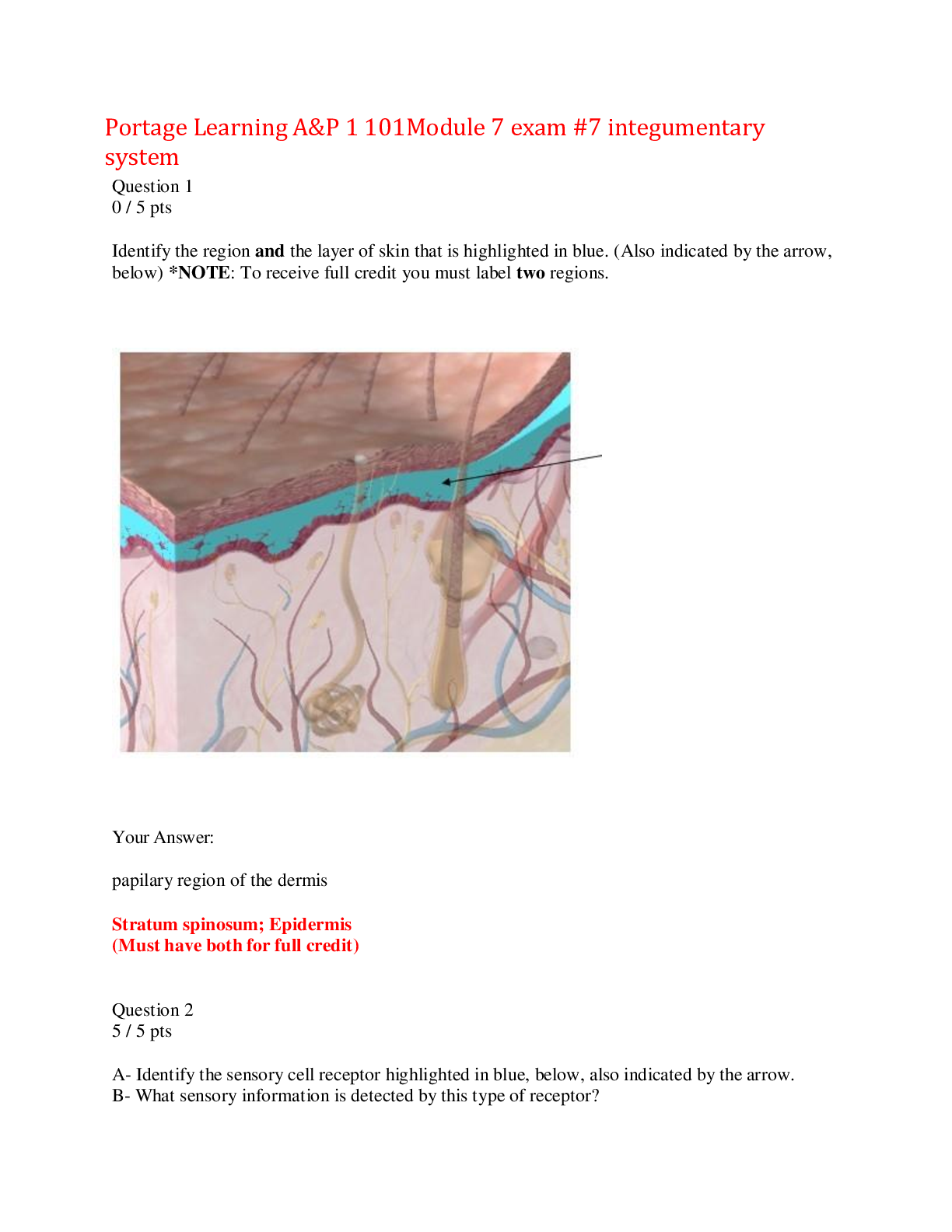
Instant download
Also available in bundle (2)

A&P 1 101 Module 1-8 Exam BUNDLE Comprehensive set Portage Learning (RATED A)
A&P 1 101 Module 1-8 Exam BUNDLE Comprehensive set Portage Learning (RATED A)
By A+ Solutions 2 years ago
$14.5
8
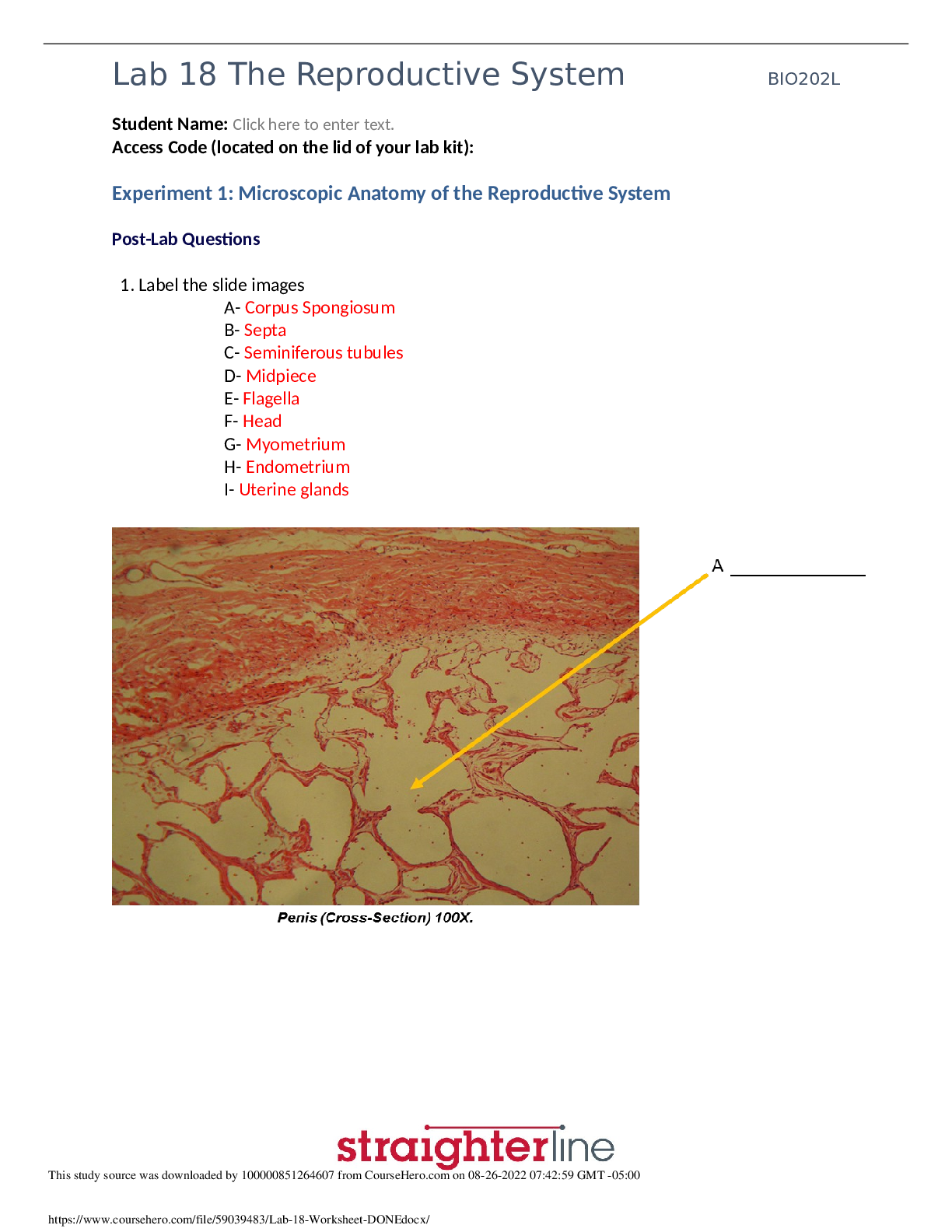
BIO 202L LAB Worksheets PACKAGE (LAB 10- LAB 18) Compiled | best Exam bundle for quick study (GUARANTEED PASS).
BIO 202L LAB Worksheets PACKAGE (LAB 10- LAB 18) Compiled | best Exam bundle for quick study (GUARANTEED PASS).
By A+ Solutions 2 years ago
$14.5
17
Reviews( 0 )
Document information
Connected school, study & course
About the document
Uploaded On
Jun 29, 2021
Number of pages
12
Written in
Additional information
This document has been written for:
Uploaded
Jun 29, 2021
Downloads
1
Views
92






.png)










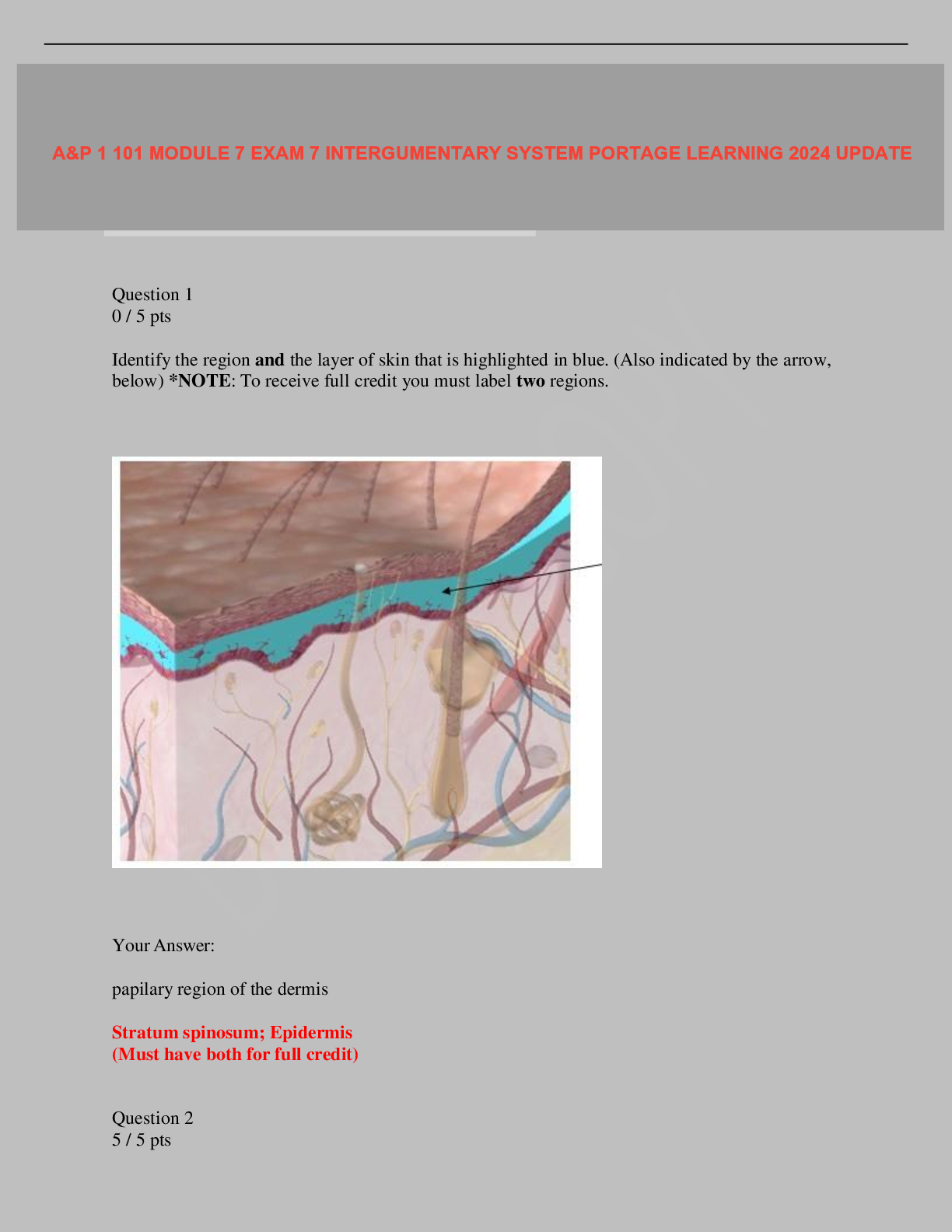


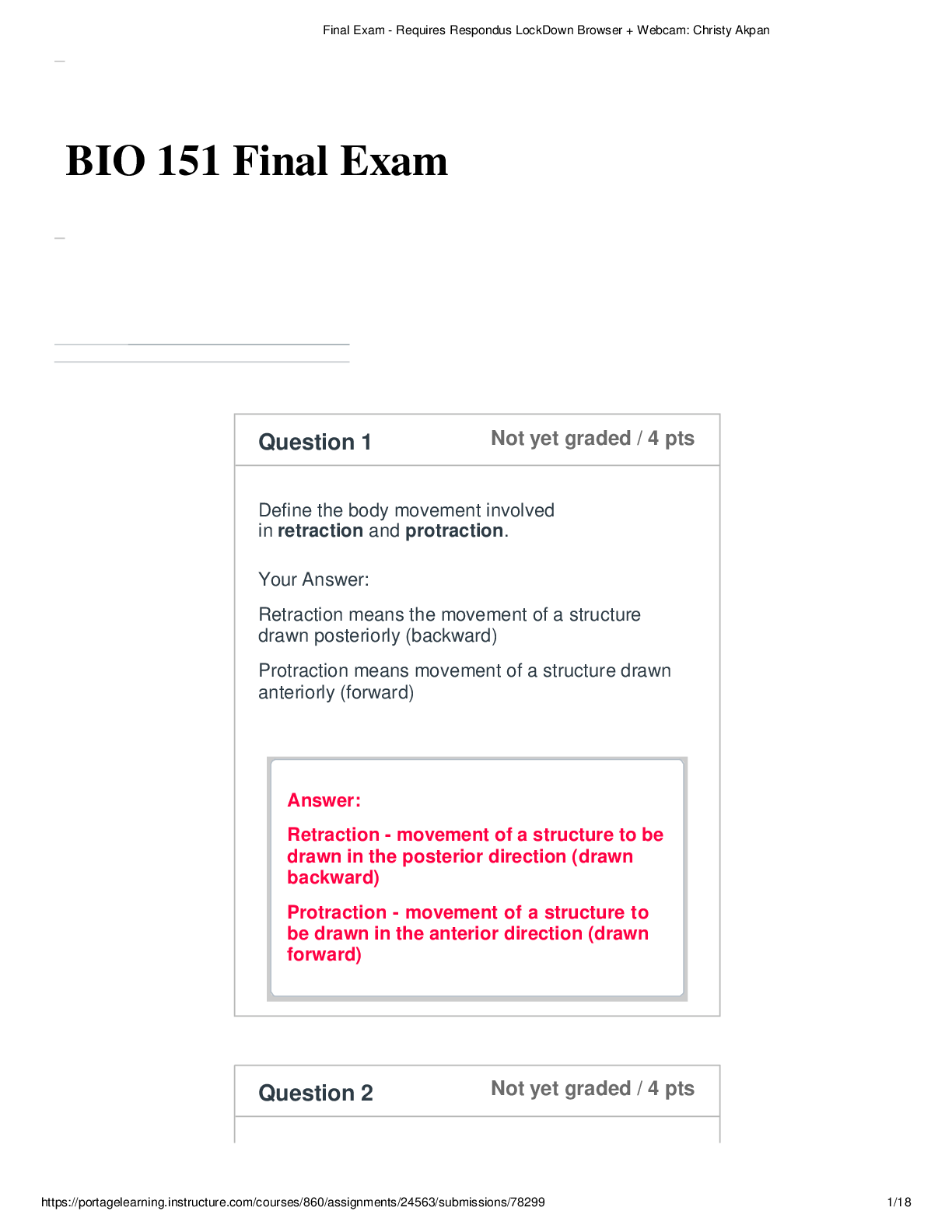
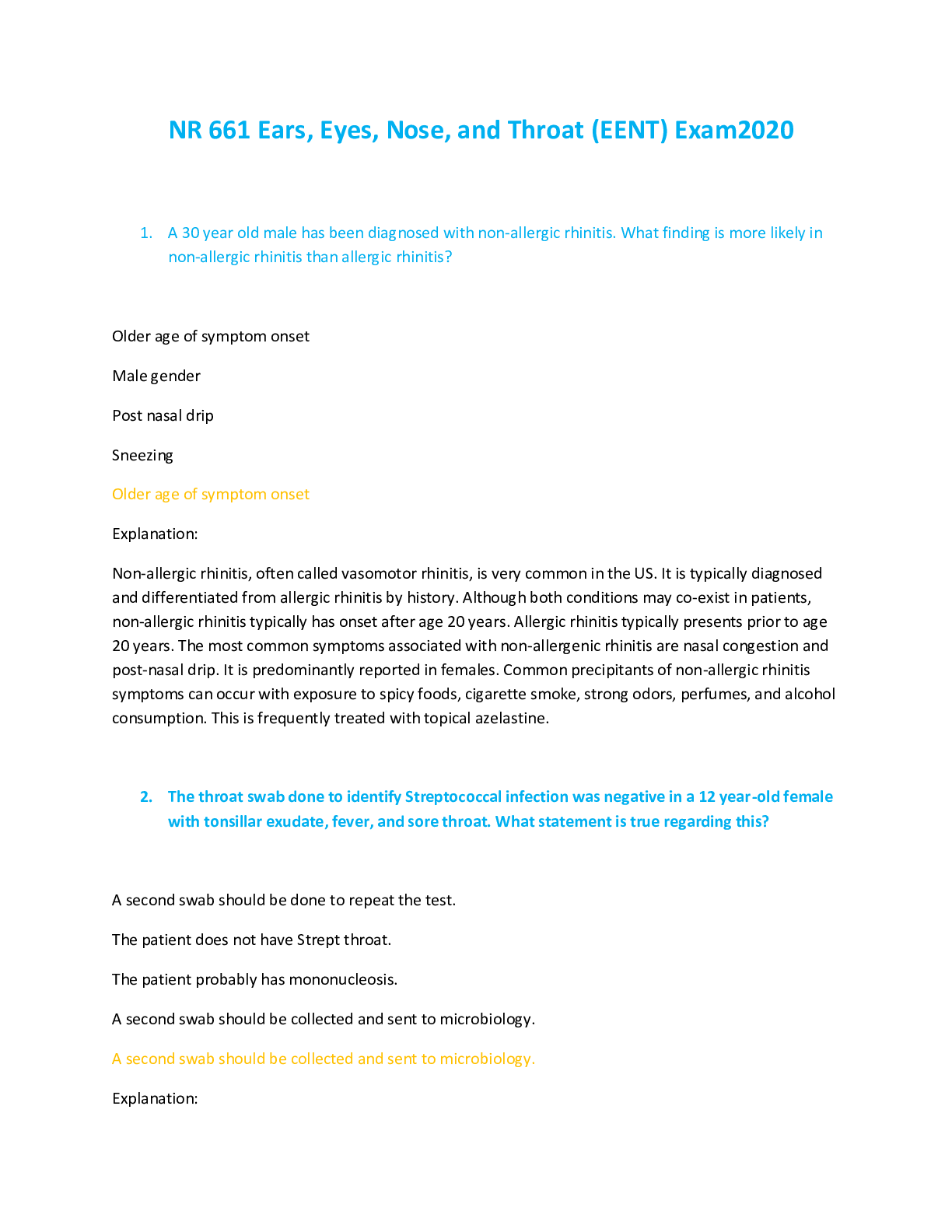



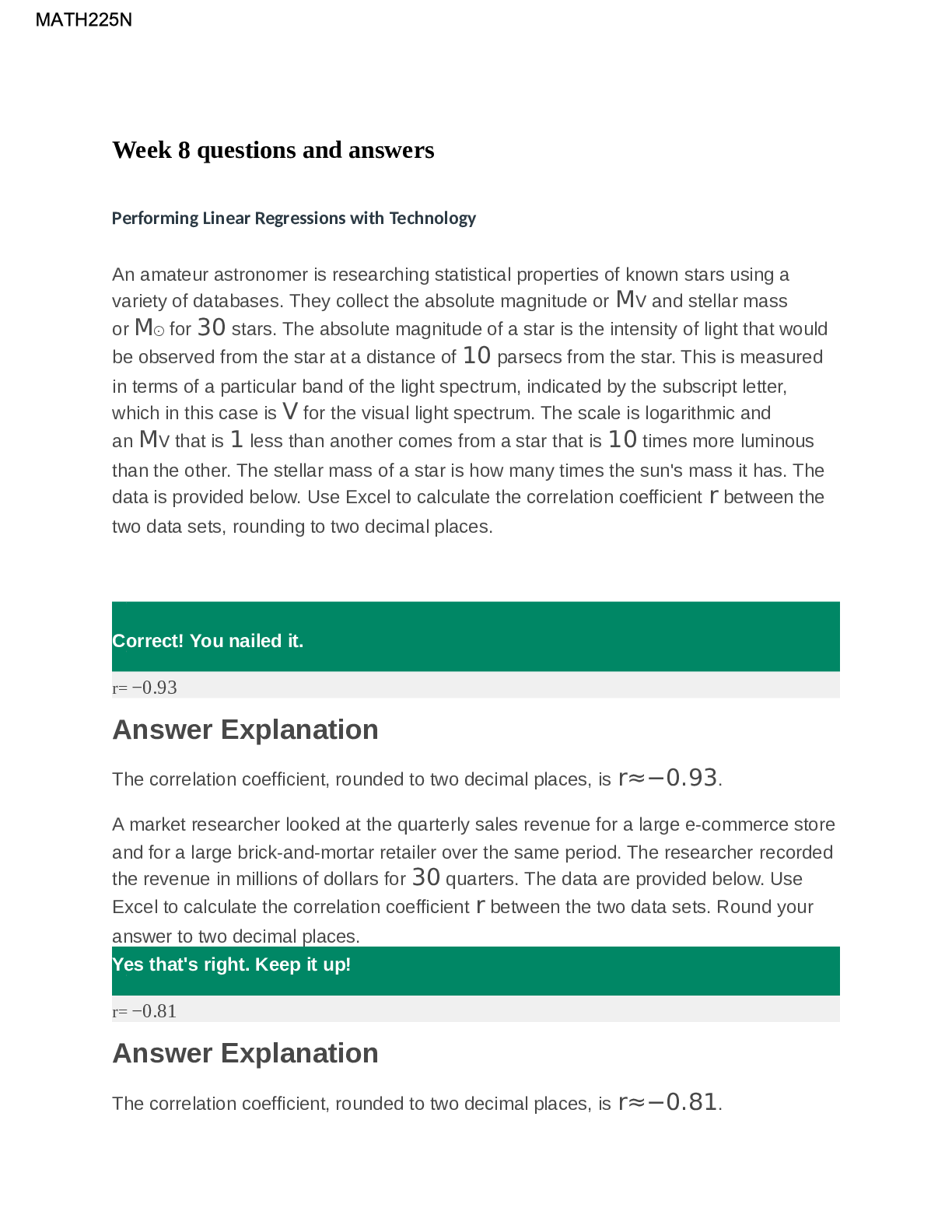

 (1).png)
